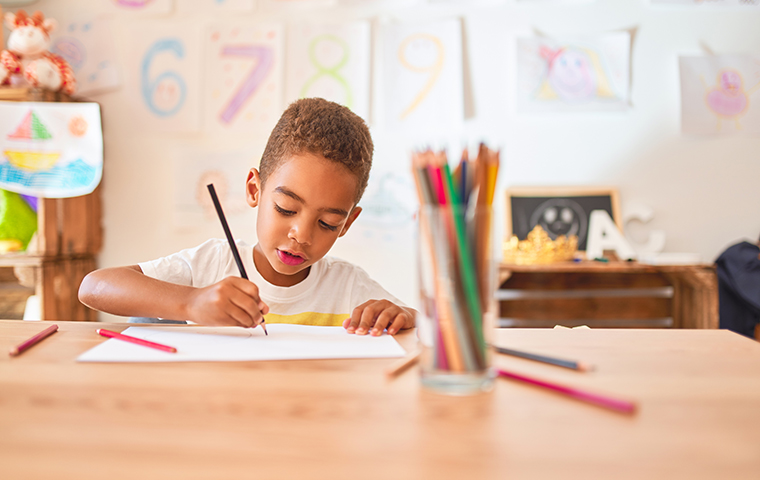Every August, kids start a new school year and it’s common for them to be nervous as they face the prospect of a new year, new teachers, and new classmates. In an ideal world, all children have supportive parents who can be with them and encourage them along the way. They have thoughtful, energetic teachers who welcome them and help them connect with their classmates. With this support, children feel more confident and more easily overcome their fears. As the days pass, they realize that school turned out to be okay and they can handle the situation. Overcoming these fears can help children build pride and resiliency, which will help them deal with other challenges later in life.
Unfortunately, many children don’t have this experience. Some have had difficult life experiences that make it harder for them to manage their stress, feel comfortable around others, and to learn and thrive. Even with supportive parents and schools, kids can’t always be protected from traumatic experiences. Childhood trauma increases the stress that children feel and undermines their ability to cope with it.
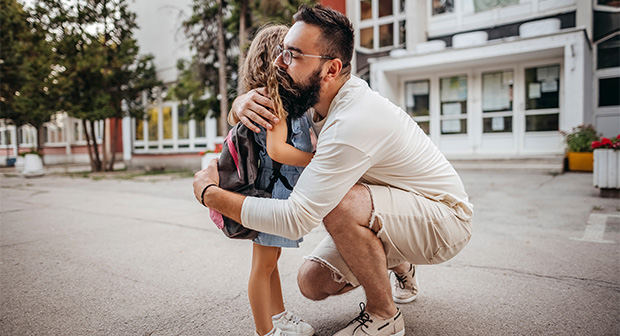
Childhood Trauma and Stress
According to the National Institute of Mental Health, childhood trauma is defined as “The experience of an event by a child that is emotionally painful or distressful, which often results in lasting mental and physical effects.” Childhood trauma and stress can be caused by many reasons:
- an illness or death in the family
- divorce
- child abuse or neglect
- a natural disaster
- food insecurities
Often, during challenging moments, a child who has experienced trauma will feel the effects of this added stress intensely, both physically and emotionally. He (or she) may struggle to cope and miss out on opportunities to build a sense of pride and resiliency. Childhood trauma affects many aspects of a child’s life, including how he manages his emotions and makes connections with others. A parent or teacher may notice a child struggling with situations at school, which is often a place trauma manifests when children can’t manage stress.
When kids help in the kitchen, they’re more likely to try and like a variety of foods.
Fortunately, there are things that parents and others can do to help children learn to cope with the effects of childhood trauma. We’ll get to that, but first it helps to understand how common childhood trauma is and how it affects a child’s brain, body, and behavior.
Childhood Trauma May Be More Common Than You Think
More than half of all children experience childhood trauma at some point in their lives, according to the American Academy of Pediatrics. The Substance Abuse and Mental Health Service Administration (SAMHSA) explains trauma as the three E’s: Events, Experiences, and Effects. Trauma is often associated with a dramatic event like a mass shooting or a major car accident. But traumatic events can be big or small, real, or something that felt real but didn’t actually happen. Ultimately, childhood trauma is based on how a child perceives or experiences an event. For example, one child who participates in a school shooting drill could see it as something that would prepare him for what to do in the case of a real emergency. Another child who participates in the same drill might see it as a real threat that could cause harm to him and his classmates. When a child experiences an event as extreme or life threatening, we begin to see the effects of childhood trauma.
The impact of childhood trauma can be short-lived or long-lasting. Some children have an immediate reaction and others have delayed responses. Signs of the effects of trauma can include medical issues, emotional reactions, behavior changes, and learning difficulties. These reactions are based on how the brain and body respond to stress.
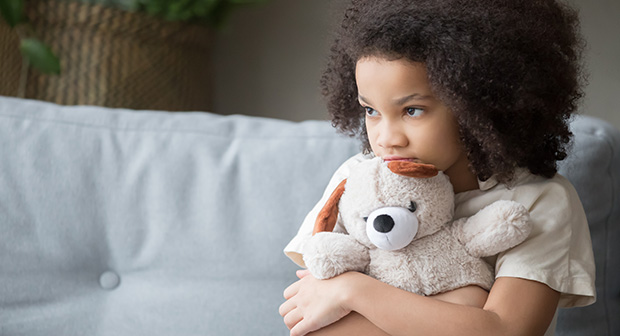
How Do Stress and Trauma Impact the Brain?
To better understand how kids respond to stress, it’s helpful to explore what stress and childhood trauma do to the brain. You might think about the base of the brain being the nervous system or senses and the top of the brain being where we do our conscious thinking and learning.
The brain takes in information at the base and then it moves to the top. It is like each life moment climbs a ladder in the brain. With each step, the brain determines whether that moment is safe to process and to keep moving forward.
At the bottom of the ladder, the base of the brain takes in sensory information, such as smells, facial expressions, or sounds. When the base of our brain determines that the situation is threatening (it doesn’t have to be a real threat), it may not allow the information from that moment to be fully processed. Since the entire moment was not processed, the response to the situation may not be appropriate. This could look like cowering in fear, ignoring others, or being disconnected from what is happening.
If the brain feels it is safe, then that moment will move up the ladder to the next level of the brain where more information about that experience is processed. The brain will then be able to determine again whether there is a threat or not. This is the part of our brain where the fight or flight response comes in. This part of the brain is very active for children who have experienced childhood trauma. They may see many things as a threat that are not really a threat. If at this stage they perceive a threat, they may stop processing the totality of the situation. They may react in a way that is inappropriate for the situation. Often parents will see reactions like aggression, outbursts, or anger.
But if the experience still feels safe, that moment will move up the ladder to the next level of the brain, where information is processed more fully. This is where children learn, connect with others, and have control over their emotions.
Here is an example of how this can play out in a simple life experience. Think of a child who sits down to take a test. He struggles with tests, especially spelling.
-
If he starts feeling stressed when he hears the spelling test being passed out (bottom of the ladder), he may just sit there and not complete it.
-
If his stress response is activated when he begins to take the test (middle of the ladder), he may rush through it just to finish or throw a tantrum to avoid taking it.
-
If he can manage the challenge through coping skills and a sense of accomplishment (top of the ladder), he can fully absorb the stress of the test and complete it to the best of his ability.
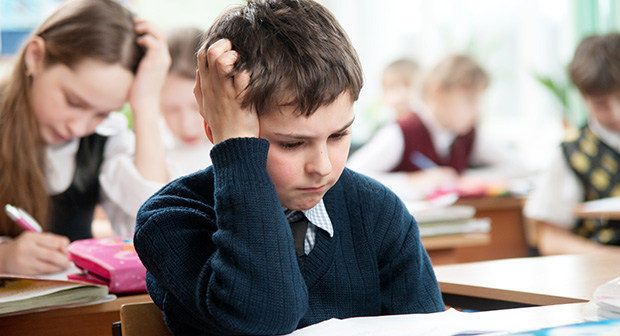
5 Ways to Help a Child Cope with Childhood Trauma
If you believe your child has experienced some sort of childhood trauma, it is important for you to remain patient and present for him. He needs to know you will be there for him no matter what, even when he is reactive or tries to push you away. You do not need to force him to tell you what has happened, but remain calm and supportive so when he feels comfortable enough to share, he knows you won’t react negatively.
You may have a feeling that your child is not coping well or struggling to manage his emotions. However, you may not know exactly what is going on. But one thing is certain: parents want to help their children through difficult times. Below are a few suggestions to help you better understand and manage these situations.
-
Manage your emotions first.
Parents want the best for their children and want to prevent them from having the same hardships that they had. But parents’ past fears and anxieties will come into play when supporting their children. Let’s use the spelling test example as a way to look at how these past fears can affect their children.
If a parent has memories of struggling with tests, they may add additional pressure by including incentives or punishments for good or bad outcomes. Some parents get anxious and on edge when helping their child prepare for the test. Some may not engage at all, because they don’t feel confident that they can help. These are all normal reactions. Unfortunately, they don’t necessarily build a child’s confidence or resiliency. Parents should be aware of their own traumatic experiences and how they affect your reactions. Some parents work with trained and trusted professionals to help navigate their own traumatic experiences. This is a win-win for you and your child.
-
Help children feel safe.
Being safe and feeling safe are different. A child can actually be safe in a situation or participating in an activity but not feel safe. This is often due to his lack of coping skills, past experiences, or anxieties. Below are some examples of being safe but not feeling safe.
- A child who just lost a family member may not want his parent to leave the home because he fears that parent may die too.
- A child who was bullied may struggle to connect with others.
- A child who is worried about how an adult might react to a challenge he is facing may not feel safe enough to have an honest conversation, even if it is actually safe to do so.
Parents need to recognize the difference between a child feeling unsafe vs. actually being unsafe so they can respond in a consistent and loving way. Think back to the example of the ladder in the child’s brain. Childhood trauma often causes children to see things as a threat that may not be real. Do your best to help your child navigate the situation by remaining calm and patient. And if you make a mistake, it’s okay. Just say you’re sorry and keep trying.
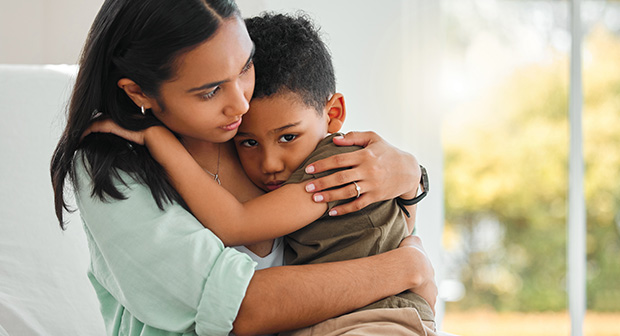
-
Focus on connecting with your child.
When children are born, parents hold them, snuggle them, and respond to their cries and needs. As they grow older, there is a transition to guiding their behavior. It is common for parents to focus so much on guiding and correcting behavior that they forget to just spend time connecting with them. Spending quality time with your child is important.
Focus on what your child likes, listen to his thoughts, and celebrate his individuality. Most important, you need to show genuine interest in him and not focus on life lessons or things that are important to you. This will help him feel safe and confident to talk to you about any challenging life situation. One of the greatest things you can do is let your child know you are always there for him, no matter what.
-
Build coping skills.
Children need to learn how to cope with life situations. They learn these skills by watching others and by practicing ways to manage stress. A helpful tool is to remember the ladder in the brain. Oftentimes children’s concerning behaviors occur when they are at the bottom of the ladder. Remember, they cannot fully take in all the information around them at this time. This is their way of telling you, “I need help regulating my body.” You can help calm your child by doing things that make him feel comfortable. This could include counting out loud, rubbing his back, holding him, giving a hug, or practicing breathing exercises. Once your child is calmer, you can help him work through ways to manage that situation better in the future. If your child regularly is unable to control his emotions, try spending time every day being active with him. This consistent activity can help his brain slowly regulate better.
Stephanie, a mom and professional counselor, shares how important it is to help kids manage their emotions. We all feel sad or angry sometimes but understanding how to handle those emotions is the key.
Licensed Professional Counselor Shares Ways to Help Kids Manage Emotions
-
Seek a trained and trusted mental health provider.
Parenting can be truly the hardest job ever! It’s natural to have uncertainties about how to help your child cope with childhood trauma but it’s okay to ask for help. Mental health providers can give you tools to help your child regulate his emotions. Each county in Texas has a mental health authority where parents can get quality mental health support—services are free or low-cost and the rest is covered by other entities.
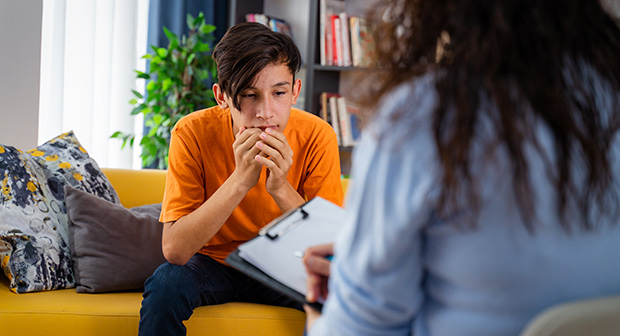
A therapist can be a big help to the whole family. Be sure to interview a few therapists to find one that is right for you. Consider asking what their understanding is about the stress response and how to support children with trauma. Some children may resist talking to a therapist. If your child does not feel comfortable sharing his feelings or experiences, ask how the therapist could still support him. Typically therapy sessions take place once a week for an hour. Remember that therapy is not a fast process—it is a commitment that takes time and work. Finding the right therapist is the first step.
Parents can also talk to their child’s school counselor for possible suggestions or find local resources here. Another great option is the Texas Parent Helpline. If you need someone to talk to, they're always ready to listen, suggest solutions, and direct you to local child services. The calls are free and confidential, and it's a great way to find one-on-one recommendations for child services near you.





